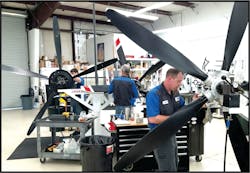The New and Old of Propeller Maintenance
The propeller – one of aviation’s more iconic images. What isn’t part of the public imagination is the work that goes into maintaining these crucial components of flight. Over the years, propeller maintenance has remained largely consistent, with advancements made on the blades themselves — namely, composite technology.
JJ Frigge, president, Hartzell Propeller Inc. said, “Composite technology continues to evolve and many new aircraft platforms have implemented composite bladed propellers for operation.”
Todd Marinkovich, service manager, American Propeller Service of Redding, California, said that the big push for change they are seeing is people transferring over to composite propellers. “The composite propellers have been around for a long duration, but they’re really getting a foothold and taking off. The main reason is, they’re lighter weight, and the reparability of them, they can keep being repaired and built back up and returned to service,” said Marinkovich.
Outside of composite, steel and aluminum are the propeller types that Frigge said Hartzell’s propellers are generally made of. The differing material requires differing repair methods. “For example, aluminum blade damage is typically removed with a file. Composite blade damage would not be removed with a file. Steel parts may require corrosion inhibitors, where aluminum parts would require Alodine to help prevent corrosion,” Frigge said.
Mike Crowell, chief inspector, American Propeller Service, added that every component in a propeller has delineated inspections for it: Areas have to be measured, visually inspected or have non-destructive testing performed on it, depending on what the part is and what the manufacturer has to have done with it. “Some of the steel parts have to be re-cadmium plated after inspection. Some of the aluminum parts need to be Alodine coated and repainted. Basically, it’s just each individual piece in that propeller has to have a pretty rigorous focus put on it to pass all inspection criteria,” Crowell said.
Maintenance from Start to Finish
When a propeller comes in to American Propeller Service, Marinkovich said the first thing they do is look the propeller over, create the repair order and send it to the shop. “The first thing that we’ll go through is a disassemble and preliminary inspection. We check track angle, balance, sometimes measure the blades at that point, and then disassemble it,” said Marinkovich.
It’s then transferred over to the cleaning and inspection department. At that point, all the parts are cleaned, stripped and go through different inspections including visual, magnification and Non-Destructive Testing (NDT) — magnetic particle, dye penetrant, and eddy current.
“After the blades are cleaned, they go into the blade department, and there, we measure all the bores and the width and thicknesses make sure they’re good. Then the blade is ground free of any rock-nicks, erosion or corrosion. And at this point, it’s etched and then dye penetrant inspected,” Marinkovich continued.
Then while that’s happening, the hub is having the same basic work performed. It’s etched, dye penetrant or magnetic particle inspected, visually inspected, measurements are taken on any areas that have required measurements and limits, and then the rest of the propellers, the miscellaneous parts and pieces are all checked by their given criteria.
Crowell added that typically, it is about a two week process from start to completed product for an aluminum propeller and around three weeks for a composite propeller, given additional coatings that have to be applied to the blades and have flash times and cure times for each.
“Propeller overhaul is a very thorough process that involves periodic disassembly, cleaning, inspecting, repairing as necessary, assembly, and testing to approved standards and technical data,” added Frigge. “Propeller repairs may include any and all of the processes required for overhaul, but are largely dependent on the unique circumstances requiring repair station assistance.”
He continued that propeller inspection and maintenance intervals vary depending on the propeller model and circumstances. Hartzell Service Letter HC-SL-61-61Y outlines overhaul periods and service life limits for propellers, governors, accumulators and propeller damper assemblies. The propeller owner’s manual also provides instructions for scheduled inspections and maintenance requirements.
“Inspections and maintenance may also be required for on-condition circumstances such as service documents and special inspections following events including foreign object strikes, lightning strikes, etc.,” Frigge said. “Repairs involve removing the damage, treating surfaces with Alodine and paint in the case of aluminum blades. Composite blade repairs would include damage removal, addition of new composite material, followed by finish procedures and paint.”
Marinkovich said that the most common damage they see is foreign object or ground strikes, however, the most common reason they reject a component is for corrosion. “We probably reject more parts for corrosion than we do for an A.D. or anything else. Often there’s excessive corrosion that is non-repairable on either the blade, hub or an internal component,” Marinkovich added.
For aluminum blades, Marinkovich noted that each time they are overhauled they get smaller and smaller until they go below a minimum width and thickness tolerance. Nicks, gouges, corrosion and scratches on blade surfaces and edges are all common damage that blades can experience.
“One advantage to the composite blade over the aluminum blade is on the composite blades you work it down to remove any wear, damage or delaminations and you build it back up. So, a lot of the composite blades have an unlimited life,” said Marinkovich.
“You can kind of compare it to a rotor on your brakes. Every time you get your brakes done they cut the rotor and it gets a little smaller, until eventually the rotor is below a minimum safe tolerance and you have to throw it away and buy a new brake rotor,” noted Marinkovich. “On the composite blades, we sand them down to remove any damage; we can even replace a leading edge and then we build the layers back up to bring it back up to the overhaul spec. So, you grind it down and build it back up, where the aluminum blades just keep getting smaller until they fall below a minimum.”
Testing and Tools
During maintenance, Hartzell may use a variety of non-destructive testing methods during repairs and overhauls including fluorescent penetrant, eddy current, magnetic particle, ultrasonic and coin tap inspections both in the shop and in the field to find defects in parts, explained Frigge. “The defects can include scratches, cracks, voids, porosity, delaminations and debonds in steel, aluminum and composite parts,” he continued. “Operational checks are performed in order to confirm proper operation of the propeller. Some of these tests include RPM checks, feather/reverse checks and proper operation of the de-ice/anti-ice system.”
“There’s eddy current, which is basically a probe-based inspection that can find discontinuities in surface or near to surface material,” Crowell said. “There’s liquid penetrant, which will find flaws that are open to the surface, magnetic particle, which is basically really similar to liquid penetrant except that it’s for ferrous steel. So, many of the parts require those non-destructive tests be done and they must be completely free of any flaw.”
Of course, testing requires tooling and Frigge stressed that it’s incredibly important to use the correct tooling when performing maintenance and tests.
“General tooling would include torque wrenches, safety wire pliers, grease gun and general hand tools. Specialized tooling may also include torque wrench adapters, shaft nut wrenches, and beta ring pullers to facilitate propeller removal and installation. C-clamps and spreader plates would also be utilized when repairing composite blades,” said Frigge.
One of the high-tech tools that American Propeller Service utilizes is an Aeroscan; an automated blade measuring machine. “Each of the blades have radius stations, and each of those radius stations have a requirement for width, thickness, angle in relation to the rest of the blade and what they call face alignment, which is where it is face to camber. And this machine uses lasers to measure all of those requirements on each of the stations of the blade,” said Crowell.
They also employ an automated rolling machine that’s produced by Hartzell, which compression rolls the blade shank on the Hartzell line of single-shoulder blades. And also employ large grinders for removing the required layer off of the aluminum blades at overhaul. “We also use a shot peen cabinet similar to the cabinet that Hartzell propeller uses for shot peening the air foils of the blades. We actually sent a tech over there to research what they use and basically got the same thing that the factory uses set up here as well. And a lot of other shops are performing that by hand,” added Marinkovich.
“Not every shop out there does their props the way that we do, as we employ the use of a vertical propeller stand rather than horizontal stand, so our technicians can actually stand up comfortably and work on the propeller without having to stoop over and try and bend over blades all day,” said Crowell.
While not a tool, American Propeller Service does offer a unique pickup and delivery service for propeller repair. “We have five route trucks covering seven western states, and all of them have custom-built aluminum flatbeds on them that are specially designed just to transport propellers safely and securely,” said James Bridgeman, general manager, American Propeller Service.
The trucks allow as many as 12 to 15 propellers to be transported at once. “We lock them all down so they’re secure and transported safely from point A to B. And they arrive at our shop for service perfectly, and we send out newly overhauled props, and they get to their destination safely, which is pretty tough to do when you’re looking at potential LTL freight, or I know some of the shops are sending props back to customers on old used car tires,” said Bridgeman.
“We’re in Redding, California and you’re in the L.A. basin. We’ll get a phone call and schedule you a pickup. We can arrange pickup, overhaul, redelivery back to L.A. and it’s usually about a three-week turn, including the pickup and delivery time,” elaborated Crowell. “And with our pickup and delivery system we have in place, the mechanic has no requirement for prepackaging or shipping. We come pick it up right at their hangar door and deliver it right back to their hangar door. And on the overhaul, that’s included in the base price of the overhaul.”






